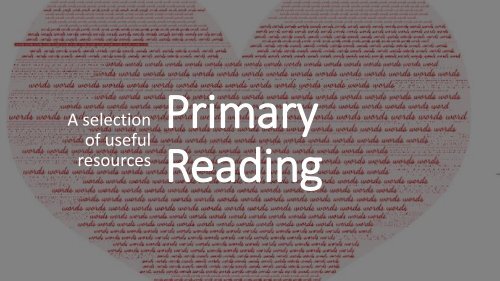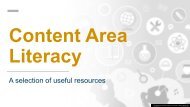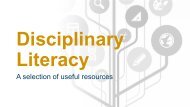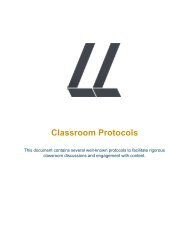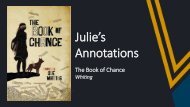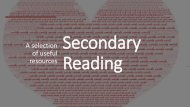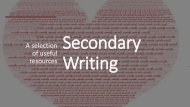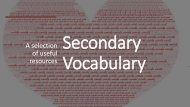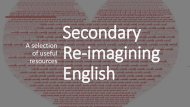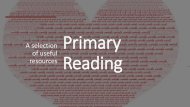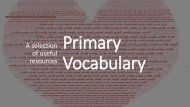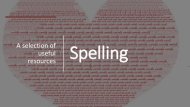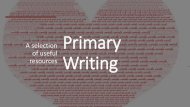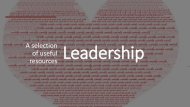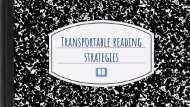Primary - Reading Magazine
Create successful ePaper yourself
Turn your PDF publications into a flip-book with our unique Google optimized e-Paper software.
A selection<br />
of useful<br />
resources<br />
<strong>Primary</strong><br />
<strong>Reading</strong>
Stephanie Harvey and Anne Goudvis share the work and<br />
thinking they've done since second edition and offer new<br />
perspectives on how to explicitly teach thinking strategies so that<br />
students become engaged, thoughtful and independent readers.<br />
Thirty new lessons and new and revised chapters highlight<br />
children's thinking, curiosity, and questions.<br />
Harvey and Goudvis tackle close reading, close listening, text<br />
complexity, and critical thinking in a new chapter on building<br />
knowledge through thinking-intensive reading and learning.<br />
Other fully revised chapters focus on digital reading, strategies<br />
for integrating comprehension and technology, and<br />
comprehension across the curriculum.<br />
Strategies That Work (3 rd edition) explains the research behind<br />
comprehension and looks at 8 strategies that should be explicitly<br />
taught to students to increase their comprehension of text. It also<br />
provides lesson ideas and student work samples.<br />
2017
The book From Striving to Thriving focuses on creating a<br />
space where students can build authentic identities as<br />
readers.<br />
Literacy specialists Stephanie Harvey & Annie Ward<br />
highlight the practices that support striving readers in<br />
building their independence and moving to agency.<br />
It includes:<br />
• latest research<br />
• ready-to-go lessons, routines, and "actions,"<br />
• part practical tips for building a literacy-rich<br />
environment, and quotes,<br />
• practices that are easily implemented in the<br />
classroom.<br />
2017
<strong>Reading</strong> with Meaning is a highly recommended book for<br />
any teacher who truly wants to empower their student’s to<br />
be a responsive, responsible and a compassionate reader.<br />
Miller show casts her newest and best thinking around<br />
comprehension instruction in her grade 1 classroom, the<br />
gradual release of responsibility and planning for students’<br />
engagement and independence.<br />
The book is well organised and reflects Miller’s professional<br />
experiences and judgment, her work in classrooms and<br />
collaboration with colleagues.<br />
2012
This expanded edition enables teachers to<br />
construct a common vision for student<br />
achievement that effectively and efficiently<br />
engages all students in the robust, authentic and<br />
meaningful literacy learning.<br />
It also provides a way to look for specific evidence<br />
of learning from foundation to grade eight, and<br />
across eight instructional contexts.<br />
2016
In this book Serravallo has collected 300 strategies that<br />
teachers can use in conferences, strategy lessons and<br />
minilessons that might include shared reading or an<br />
interactive read aloud.<br />
Each strategy provides:<br />
• teaching tips<br />
• cross-links to skills, genres, and the Fountas &<br />
Pinnell reading levels<br />
• lesson language described<br />
• prompts to use that encourage the reader to do the<br />
thinking, talking, jotting as they work with the<br />
strategy<br />
• anchor chart examples<br />
• references to other authors and books<br />
• student work examples.<br />
This book is also useful for planning units of study.<br />
2015
Understanding Texts & Readers maps out the four fiction<br />
and four nonfiction comprehension goals Serravallo<br />
presented in The <strong>Reading</strong> Strategies Book, to fourteen text<br />
levels. It presents sample responses that show what to<br />
expect from readers at each.<br />
The book explores the characteristics of both fiction and<br />
nonfiction texts and provides support for teachers to build an<br />
understanding of how these characteristics change as text<br />
become more complex.<br />
2018
Serravallo’s book presents an approach to assessment,<br />
planning, and teaching. She provides a four-step<br />
assessment protocol to help develop effective differentiate<br />
reading and writing goals, and then makes an action plan<br />
with targeted instruction alongside students in Foundation<br />
to Year 2.<br />
Her four-step assessment protocol is:<br />
• collect data - student work and everyday<br />
assessments (that will be the most useful to you)<br />
• analyse the data to understand deeply what kids<br />
know and can do<br />
• synthesize data from multiple assessments to<br />
create learning goals<br />
• develop instructional plans and follow-ups to<br />
monitor progress.<br />
2014
Serravallo’s book presents an approach to assessment,<br />
planning, and teaching. She provides a four-step<br />
assessment protocol to help develop effective differentiate<br />
reading and writing goals, and then makes an action plan<br />
with targeted instruction alongside students in Years 3 - 6.<br />
Her four-step assessment protocol is:<br />
• collect data - student work and everyday<br />
assessments (that will be the most useful to you)<br />
• analyse the data to understand deeply what kids<br />
know and can do<br />
• synthesize data from multiple assessments to<br />
create learning goals<br />
• develop instructional plans and follow-ups to<br />
monitor progress.<br />
2013
In the book, Distrusting Thinking authors Beers & Probst<br />
tackle one of teachers’ greatest challenges: student apathy.<br />
They explain that too many students remain disengaged<br />
and reluctant readers due to the misrepresentation they<br />
continue to receive regarding why we read and how we<br />
should approach the texts we read.<br />
Distrusting Thinking is an exploration of how teachers help<br />
students become critical thinkers.<br />
The book presents a vision of what reading and what<br />
education across all the grades could be. It presents new<br />
strategies and ideas that help classroom teachers create<br />
engagement and relevance; encourage responsive and<br />
responsible reading; deepen comprehension and develop<br />
lifelong reading habits.<br />
Their collaborative writing is highly readable and witty, and<br />
on point.<br />
2017
The new edition of Still Learning to Read focuses on the needs of<br />
students in grades 3–6 in all aspects of reading workshops,<br />
including read-aloud, classroom design, digital tools, fiction,<br />
nonfiction, and close reading.<br />
The book stays true to its original beliefs of slowing down and<br />
knowing our readers, but it also takes into account the sense of<br />
urgency that changing times and standards impose on classrooms.<br />
This edition examines current trends in literacy, includes a new<br />
section on intentional instructional planning, and provides expanded<br />
examples of mini-lessons and routines that promote deeper thinking<br />
about learning.<br />
It also includes a new chapter on scaffolding for reading nonfiction<br />
and captures Sibberson & Symusiak’s latest thinking on close<br />
reading and text complexity.<br />
Online videos provide glimpses into classrooms as students make<br />
book choices, work in small groups, and discuss their reading<br />
notebooks.<br />
Expanded and updated book lists, recommendations for digital<br />
tools, lesson cycles, and sections specifically written for school<br />
leaders round out this foundational resource.<br />
2016
This is a practical book for teachers. Miller provides teachers with a<br />
variety of tools that are designed to support their students, of all<br />
levels, on their path to reading successfully.<br />
Miller describes the inherent need children have to engage with<br />
books, intellectually and emotionally; she embraces giving students<br />
choice and time to read books they pick out themselves.<br />
Her unconventional approach is simple yet provocative:<br />
• affirm the reader in every student<br />
• allow students to choose their own books<br />
• carve out extra reading time<br />
• model authentic reading behaviours<br />
• discard timeworn reading assignments such as book<br />
reports and comprehension worksheets, and<br />
• develop a classroom library filled with high-interest books.<br />
2009
Gravity Goldberg’s book Mindsets and Moves: Strategies<br />
That Help Readers Take Charge shows teachers how to think<br />
about and interact with children around literacy. It is a<br />
resource that guides teachers to help their students feel<br />
empowered to take ownership over their reading identities.<br />
Goldberg’s practical book has examples of lessons,<br />
minilessons, models, tools, student sticky note examples as<br />
well as visual examples of anchor charts.<br />
Goldberg challenges current practices around reading and<br />
encourages teachers to reflect and strengthen their own<br />
identity, beliefs, and values as educators.<br />
2015
Beyond Leveled Texts (second edition) is an updated edition<br />
to the author's first book Beyond Leveled Books. This new<br />
book draws on their continued research and provides a<br />
much-needed perspective on moving transitional readers<br />
from basic supports to independent book selection.<br />
The text also provides support in developing an<br />
understanding of the transitional reader and meeting their<br />
needs.<br />
Szymusiak, Sibberson & Koch also challenge the overuse of<br />
levelled texts for our early readers.<br />
2007
Miller & Moss review recent research-based techniques<br />
on independent reading and the reading workshop. Their<br />
concise overviews make a compelling case for bringing<br />
independent reading back to our critical daily practice.<br />
No More Independent <strong>Reading</strong> Without Support<br />
discusses the critical practices required for independent<br />
reading to be effective.<br />
It distinguishes between silent reading, DEAR and highquality<br />
independent reading and provides research<br />
around these practices. It also challenges readers to<br />
implement purposeful independent reading time for all<br />
students.<br />
2013
The book Letter Lessons and First Words: Phonics<br />
Foundations That Work provides a research-based vision of<br />
what engaging differentiated, sequential and explicit phonics<br />
instruction can look like.<br />
Mesmer provides basic information about how the English<br />
system of writing works which is vital knowledge if teachers<br />
are going to be effective in their teaching.<br />
A clear scops and sequence of what to teach, and a quick<br />
assessment that enables teachers to place students in the<br />
appropriate unit of instruction is included.<br />
Videos show students working with letters, words, and books<br />
at various stages of their learning.<br />
Practical activities are also described.<br />
2019
Palmer & Invernizzi present teaching practices that do not<br />
rely on or use one-size-fits-all approach.<br />
The book digs into:<br />
• assessment of word knowledge<br />
• differentiation<br />
• myths about English spelling<br />
• critical practices for word study<br />
• links between spelling and vocabulary<br />
• deep engagement with words.<br />
2014
This book provides a comprehensive guide that shows<br />
teachers how to determine what readers have learned and<br />
what they need to practice. It then provides suggestions<br />
for targeting instruction to meet students’ needs.<br />
You’ll learn how to:<br />
• research a student’s use of skills through<br />
questions and observations<br />
• compliment to support and build upon successes<br />
• follow up on prior instruction for accountability<br />
and depth of understanding<br />
• explain a reading strategy by providing an explicit<br />
purpose and context<br />
• model the strategy to make the invisible<br />
brainwork of reading more visible<br />
• guide a reader in practicing the strategy<br />
• link the strategy to independent reading.<br />
2007
This book by Patrick Allen provides valuable instructional<br />
support to all teachers. Conferring: The Keystone of<br />
Reader’s Workshop is regarded as a benchmark text as it<br />
helps teachers to not only think about children, reading and<br />
thinking, but also helps them discover the strength, power<br />
and necessity of conferring with student readers.<br />
Allen explores the fundamentals of conferring and provides<br />
excellent techniques and prompts that lead teachers through<br />
the components of effective reading conferences from start<br />
to finish.<br />
Throughout the book, it is proven that by adopting excellent<br />
approaches of conferring with independent readers, nonreaders<br />
are transformed into avid readers.<br />
2009
A Teacher’s Guide to <strong>Reading</strong> Conferences is a quick,<br />
clear and easy to read resource for teachers who want<br />
to make a change and want to do it right away.<br />
What’s included:<br />
• Jen’s moves and language<br />
• 9 videos of her teaching in K–8 classrooms<br />
• 13 conference note-taking forms—one for each<br />
reading goal from the hierarchy in her <strong>Reading</strong><br />
Strategies Book<br />
• Suggestions for connecting emergent bilingual<br />
learners’ language goals and reading goals.<br />
2019
So What Do They Really Know? includes a wealth of information,<br />
specifically exploring the complex issue of monitoring, assessing, and<br />
grading students' thinking and performance with fairness and fidelity.<br />
Tovani shows teachers how to use assessments to monitor student<br />
growth and provides targeted feedback that enables students to master<br />
content goals. She also shares ways to bring students into the<br />
assessment cycle so they can monitor their own learning, maximizing<br />
motivation and engagement.<br />
Topic include:<br />
• Lessons from Cris's classroom<br />
• Templates showing how teachers can use the workshop<br />
model to assess and differentiate instruction<br />
• Student work, including samples from linguistically diverse<br />
learners, struggling readers, and college-bound seniors<br />
• Anchor charts of student thinking<br />
• Ideas on how to give feedback<br />
• Guidelines that explain how conferring is different from<br />
monitoring<br />
• Suggestions for assessing learning and differentiating<br />
instruction during conferences<br />
• Advice for managing ongoing assessment<br />
2010
Creating Lifelong Readers Through Independent<br />
<strong>Reading</strong> provides concrete suggestions for creating<br />
independent reading programs that make a<br />
difference.<br />
Practical tools and tips for creating classroom<br />
libraries, guidelines for self-selection of texts and<br />
lesson ideas are included.<br />
There are links to current research and insightful<br />
interviews with literacy leaders, Richard Allington.<br />
Linda Gambrell, Tony Stead, Sharon Taberski and<br />
Myra Zarnowski.<br />
2010
In Notebook Connections, Buckner focuses on - the reading<br />
workshop, showing teachers how to support students to use a<br />
reader’s notebooks as a place to document their thinking and<br />
growth, to support their thinking for group discussions, and to<br />
explore their own ideas about a text.<br />
Buckner describes her model as flexible enough for students to<br />
respond in a variety of ways yet structured enough to provide<br />
explicit instruction.<br />
Notebook Connections leads teachers through the process of<br />
launching, developing, and fine-tuning a reader’s notebook<br />
program.<br />
Teacher-guided lessons in every chapter help students create<br />
anchor texts for their notebooks using various comprehension<br />
and writing strategies.<br />
Notebook Connections is filled with lesson ideas and assessment<br />
tips.<br />
2009
Carefully revised from the first edition published ten years<br />
ago, this book reflects the latest thinking by Keene &<br />
Zimmerman. It is deep, thought provoking and designed to<br />
help teachers implement practical, thoughtful ideas for<br />
teaching comprehension.<br />
Seven core strategies that successful readers use to engage<br />
with texts are also explored. Key ideas and concepts for<br />
each strategy, new classroom examples, new tools and<br />
innovations for think-aloud and conferring practices and<br />
included.<br />
There is also new advice from Keene & Zimmerman as well<br />
as an invaluable Q&A section with informed responses to<br />
questions frequently asked by today’s teachers.<br />
2007
Ellin Oliver Keene demystifies comprehension instruction by<br />
describing what it can look like when readers comprehend deeply<br />
and what it can look like when teachers aim for this deep<br />
comprehension.<br />
This book offers the following:<br />
• Outcomes of Understanding - These are descriptions of the<br />
behaviours present when children understand a text deeply,<br />
including ways to assess with and teach toward these outcomes.<br />
• Talk About Understanding – These are suggestions to modify<br />
teaching language and teaching interactions to deepen children's<br />
ability to comprehend<br />
• From the Inside - These are video segments of Ellin in action.<br />
2012
Comprehension Connections creates a framework and a<br />
guide for teaching comprehension strategies that can be<br />
complicated or abstract.<br />
The lessons aim to make abstract thinking accessible to<br />
primary students.<br />
The approach sequences stages of learning for each strategy<br />
that takes students from a fun object lesson to a deeper<br />
understanding through writing, discussion, song, art and<br />
movement.<br />
Six core strategies that successful readers use to engage with<br />
texts are explored. The strategies are schema, inferring,<br />
questioning, determining importance, visualising and<br />
synthesising.<br />
2007
Teaching <strong>Reading</strong> Comprehension Strategies is a step-bystep<br />
guide on how to introduce and teach reading<br />
comprehension strategies and how they fit into your literacy<br />
program.<br />
Each strategy has its own chapter, with:<br />
• an explanation of the strategy and how it supports<br />
comprehension<br />
• the language we use when using a strategy<br />
• guided and independent student activities that support<br />
teaching the strategy.<br />
2009
Mini-lessons for Literature Circles focuses on<br />
supporting teachers to build respectful classroom<br />
communities, deepen their student’s book discussions<br />
and create lifelong readers.<br />
There are forty-five short, focused, practical and<br />
teacher-directed lessons that begin, guide and followup<br />
every successful book club meeting.<br />
2004
Comprehension and Collaboration: Inquiry Circles in<br />
Action provides a guide for teachers who want to<br />
implement well-structured, student-led, cross-curricular<br />
projects.<br />
It lays the foundation for inquiry circles by discussing the<br />
current research and practices behind comprehension<br />
instruction and classroom collaboration.<br />
2004
Wilhelm shows how he teaches students how to recognise and<br />
make meaning. The approach he uses is based on the gradual<br />
release of responsibility principle. He further explains why Think-<br />
Alouds are a sound strategy for translating this principle into<br />
practice. Wilhelm also explores powerful reading techniques like<br />
inferring, visualisaing, summarizing, making connections to real<br />
life, plus many more.<br />
Brief lessons, practical activities, classroom scenarios and<br />
sample students work are included.<br />
Use this book to help your students learn how to read better!<br />
2001


